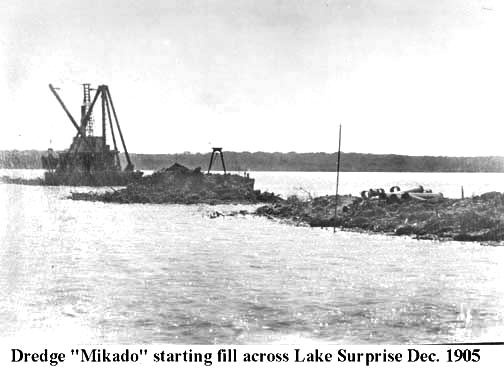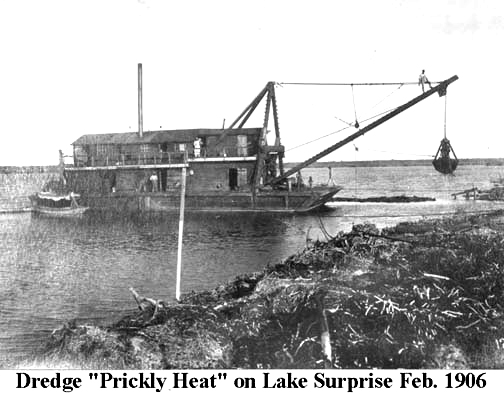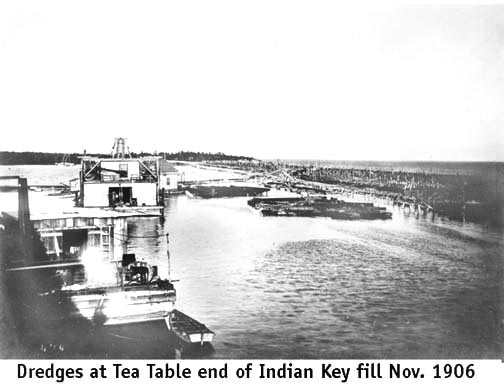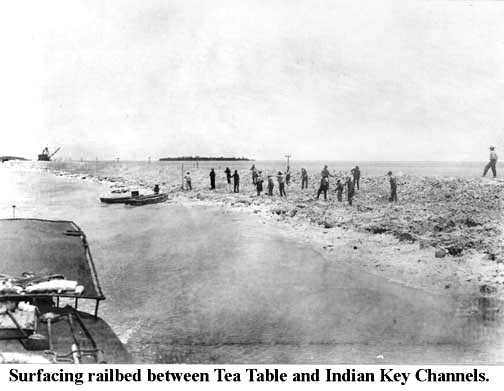Building the railroad that Went to Sea with photos.
Page 2
Fill railbed over open water
The photos below are of the Upper Keys, but
the methods were repeated throughout the Keys. The length of the fill and
the associated water depth varied the methods a little. The Hurricane of
1906, however, emphasized the change from marl on the inside and rock on
the outside to the opposite. Clean ocean marl sets up almost like concrete
when allowed to cure.
Lake Surprise and Indian Key Fill were examples
of making a causeway across open water. Indian Key Fill was different as
it had to withstand ocean waves, winds and tidal action. It was also effectively
a group of short bridges connected by segments of causeway.
It appears that the first dredges were deployed
to the Everglades and Lake Surprise areas. This supports the theory that
they wanted to lay track as quickly as possible from Miami/Homestead as
possible. The lack of a portable concrete mixer delayed the completion
of the Jewfish Creek Bridge. Then it was discovered that the Lake Surprise
causeway was not stable. Most of the special floating construction equipment
was made from Mississippi River barges as a foundation. This will be shown
later.
 The lack of piling and side bulkheads combined
with the different marl dredged up from Lake Surprise made a very weak
railbed. The story has it that it took 15 months to stabilize the railbed
to consistently support daily operation of a loaded construction train.
Even years later it was a problem for the Department of Transportation
for vehicle travel.
The lack of piling and side bulkheads combined
with the different marl dredged up from Lake Surprise made a very weak
railbed. The story has it that it took 15 months to stabilize the railbed
to consistently support daily operation of a loaded construction train.
Even years later it was a problem for the Department of Transportation
for vehicle travel.
 From the Indian Key Fill images below, it is clearly
seen that lateral support was provided. The ocean marl also sets (hardens)
much firmer than the humus riddled Lake Surprise marl.
From the Indian Key Fill images below, it is clearly
seen that lateral support was provided. The ocean marl also sets (hardens)
much firmer than the humus riddled Lake Surprise marl.
 In the above photo, the obviously flat railbed
is actually the bridge portion across the Tea Table Channel. Regardless
of the fill, very little rock was hauled in as fill, except for bridge
approaches and low spots on the islands (Dove Creek and connecting the
Umbrella Keys.)
In the above photo, the obviously flat railbed
is actually the bridge portion across the Tea Table Channel. Regardless
of the fill, very little rock was hauled in as fill, except for bridge
approaches and low spots on the islands (Dove Creek and connecting the
Umbrella Keys.)

A major supply depot called "Central Supply" was
constructed on the sides of Indian Key Fill and a draw bridge installed
for ocean and bay access. It is believed that this was the area referred
to as "Ocean City" by newspapers.
 Next, we will move on to the construction of railbeds
on island hammock surfaces.
Next, we will move on to the construction of railbeds
on island hammock surfaces. |